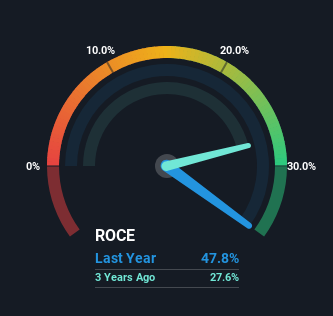- United Kingdom
- /
- Specialty Stores
- /
- LSE:DNLM
Investors Should Be Encouraged By Dunelm Group's (LON:DNLM) Returns On Capital
If you're looking for a multi-bagger, there's a few things to keep an eye out for. Firstly, we'd want to identify a growing return on capital employed (ROCE) and then alongside that, an ever-increasing base of capital employed. Basically this means that a company has profitable initiatives that it can continue to reinvest in, which is a trait of a compounding machine. Speaking of which, we noticed some great changes in Dunelm Group's (LON:DNLM) returns on capital, so let's have a look.
Return On Capital Employed (ROCE): What Is It?
For those who don't know, ROCE is a measure of a company's yearly pre-tax profit (its return), relative to the capital employed in the business. Analysts use this formula to calculate it for Dunelm Group:
Return on Capital Employed = Earnings Before Interest and Tax (EBIT) ÷ (Total Assets - Current Liabilities)
0.48 = UK£204m ÷ (UK£721m - UK£294m) (Based on the trailing twelve months to December 2023).
Therefore, Dunelm Group has an ROCE of 48%. In absolute terms that's a great return and it's even better than the Specialty Retail industry average of 14%.
Check out our latest analysis for Dunelm Group

In the above chart we have measured Dunelm Group's prior ROCE against its prior performance, but the future is arguably more important. If you'd like to see what analysts are forecasting going forward, you should check out our free analyst report for Dunelm Group .
What Does the ROCE Trend For Dunelm Group Tell Us?
The trends we've noticed at Dunelm Group are quite reassuring. Over the last five years, returns on capital employed have risen substantially to 48%. Basically the business is earning more per dollar of capital invested and in addition to that, 48% more capital is being employed now too. So we're very much inspired by what we're seeing at Dunelm Group thanks to its ability to profitably reinvest capital.
On a side note, Dunelm Group's current liabilities are still rather high at 41% of total assets. This can bring about some risks because the company is basically operating with a rather large reliance on its suppliers or other sorts of short-term creditors. Ideally we'd like to see this reduce as that would mean fewer obligations bearing risks.
In Conclusion...
To sum it up, Dunelm Group has proven it can reinvest in the business and generate higher returns on that capital employed, which is terrific. And investors seem to expect more of this going forward, since the stock has rewarded shareholders with a 59% return over the last five years. So given the stock has proven it has promising trends, it's worth researching the company further to see if these trends are likely to persist.
If you want to continue researching Dunelm Group, you might be interested to know about the 1 warning sign that our analysis has discovered.
If you'd like to see other companies earning high returns, check out our free list of companies earning high returns with solid balance sheets here.
New: Manage All Your Stock Portfolios in One Place
We've created the ultimate portfolio companion for stock investors, and it's free.
• Connect an unlimited number of Portfolios and see your total in one currency
• Be alerted to new Warning Signs or Risks via email or mobile
• Track the Fair Value of your stocks
Have feedback on this article? Concerned about the content? Get in touch with us directly. Alternatively, email editorial-team (at) simplywallst.com.
This article by Simply Wall St is general in nature. We provide commentary based on historical data and analyst forecasts only using an unbiased methodology and our articles are not intended to be financial advice. It does not constitute a recommendation to buy or sell any stock, and does not take account of your objectives, or your financial situation. We aim to bring you long-term focused analysis driven by fundamental data. Note that our analysis may not factor in the latest price-sensitive company announcements or qualitative material. Simply Wall St has no position in any stocks mentioned.
About LSE:DNLM
Established dividend payer and good value.
Similar Companies
Market Insights
Community Narratives



